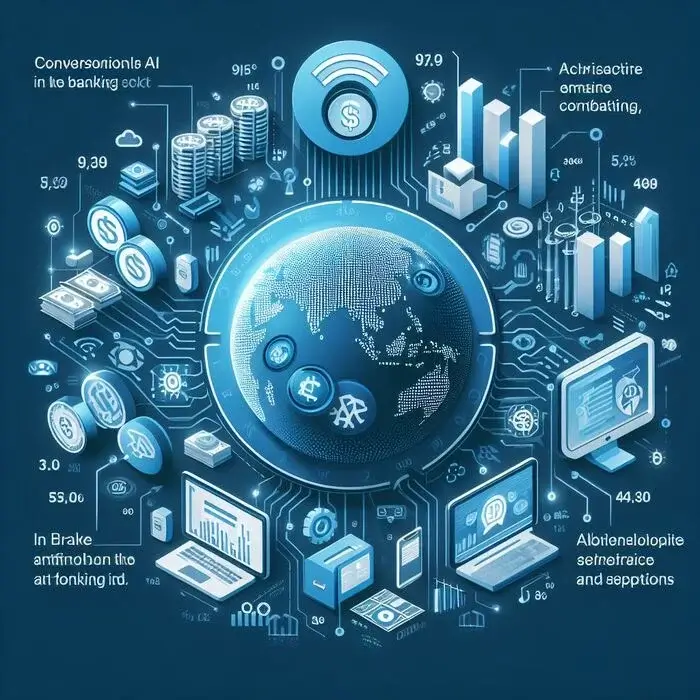Do you know how you had to wait 20 minutes on hold just to ask a simple question about your account balance? Ugh, the stress. The pressure, ugh. Conventional banking methods may be time-consuming and confusing. All of us have been there. However, many things are changing now that speech-based AI (CAI) is in charge.
Imagine having a friendly financial helper who is available 24 hours a day, seven days a week to answer your questions, handle your transactions, and even give you personalized advice. That’s what Conversational AI in banking says it will do, and trust me, it’s not just talk. As a writer who is good with technology and always on the lookout for new ideas, I’m here to talk about this cool trend and see how it might change the way we handle our money.
What is Conversational AI in Banking?
Conversational AI in Banking is like having a trustworthy financial co-pilot with you. It is powered by AI and natural language processing. It can look like robots on the websites of banks or mobile apps, voice helpers like Google Assistant or Alexa that are built into banking systems, or even smart speakers in bank offices. These AI assistants can understand your questions and requests and answer them quickly and correctly, so you don’t have to wait on hold.
But don’t think of them as robots that are just reading lines. Advanced Conversational AI in Banking does more than just talk to you. It looks at your past transactions and tastes to give you personalized advice and financial insights. As if you had a nice guide (or rather, a digital one) at your fingers, always ready to give a hand.
Latest Trends and Developments Conversational AI in Banking
Conversational AI in banking is a rapidly evolving subject with interesting new developments occurring often. These are some important trends:
- AI helpers are no longer limited to certain platforms, allowing for seamless digital experiences. They are combining talk, chat, mobile apps, and even real stores to make banking easier and more linked.
- As technology improves, security steps get smarter to keep your banking information safe. Transparency and giving users power over how their data is used are also very important things to think about.
- Focus on your financial health. AI can help you with more than just transactions; it can also help you with planning, giving you specific advice, and even managing your credit score.
- As AI’s use grows, officials are putting out rules to make sure that it is developed responsibly and that data is used in an acceptable way in the financial sector.

Use Cases of Conversational AI in Banking
Remember how long the waits were, how hard it was to figure out the choices, and how cold the people you talked to at the bank were? Conversational AI in Banking is changing the game by giving robots, voice helpers, and smart speakers helpful, always-on financial aid.
But what can these AI friends really do? Hold on tight, because the use cases are many and important:
1. Managing your Account and Transactions
- Check your account amounts and transaction records without having to log in. Just ask your AI helper to give you account reports.
- Move money from one account to another: Voice instructions or text messages make it easy to move money.
- You can pay your bills anywhere. Helper AI that talks to you can help you pay your bills quickly and safely.
- Keep track of and control spending. See how much you’re paying in real time and make your own budgets.
2. Personalized Customer Service and Support
- You can ask your AI helper any question and get an answer right away. It can help you with anything from prices to product information.
- Answer basic questions. Don’t waste time on long calls; quickly handle account problems like lost cards or forgotten PINs.
- Take complicated issues to a higher level. when you need it, AI connects you smoothly to human workers who can give you personalized help.
- Support in multiple languages. AI-powered customer service makes sure that everyone can get help.
3. Financial Guidance and Insights
- Get personalized financial advice. AI can offer planning plans and good financial items based on how you normally spend your money.
- Keep an eye on your credit score and improve your financial health. Proactive tips and useful advice can help you keep an eye on your credit score and make smart choices.
- Investment suggestions. Get investment ideas that are based on your financial goals and how much risk you are willing to take.
- Tools for learning about money: Use learning materials and engaging tools to get a better grasp on financial ideas.
4. Better Experience at the Branch
- With interactive booths and smart speakers, you can get help with jobs, find out about goods, and quickly find your way around the shop.
- gifts and deals that are just for you: Use AI to find people who have bought from you before and give them personalized help or special deals.
- Product displays in stores: Use AI to make it interesting to learn about the features and perks of banking goods.
5. Safety and Stopping Fraud
- Multi-factor Authentication: AI can add extra layers of security when you make purchases or access private data.
- Real-time Scam Detection: Spot fishy behavior right away and warn customers about possible threats.
- Safe Handling of Passwords: Use AI to store and change passwords safely.
6. More than Just Dealing with Customers
- Simplify internal processes: Use AI to handle jobs like handling data, approving loans, and analyzing documents. This will save time and money.
- Market study and reading between the lines: Use AI to look at how customers connect with your business and learn how to make your goods and services better.
- Compliance and legal checks: Make sure you follow the rules by automating compliance jobs.

Popular Conversational AI in Banking and How to Use Them
Conversational AI in Banking is changing the way banks work by making conversations easier and more personal. Here are some of the most popular ones like IBM Watson Assistant, Google Dialogflow Amazon Lex, etc. You can check this post Conversational AI in Retail: Trends, Use Case, Popular AI to get a brief knowledge about them and how to use these tools.
The Future of Conversational AI in Banking
The way we deal with our money is changing because of Conversational AI in Banking. As people who work in finance, it’s our duty to use its power in an honest and responsible way. By doing this, we can make banking easier, more specialized, and more open to everyone, which will lead to a better future for the business.
Don’t forget that CAI is not a substitute, but a partner. We can open the door to a new age of financial freedom and growth by recognizing its promise and carefully handling its obstacles.
Surveys on Conversational AI in Banking in the USA
| Survey Title | Conducted By | Key Findings |
|---|---|---|
| The State of Consumer Trends in Shopping 2024 | Sensor Tower 2024 | 62% of smartphone owners in the US shop online, and 44% use mobile banking apps. |
| Consumer Preferences for Conversational Commerce | LivePerson 2020 | 88% of people in the US are willing to text brands, and 79% would spend more with banks that let them text. |
| The 2024 US Mobile Banking Consumer Report | Cornerstone Advisors 2024 | 79% of people in the US who use mobile banking do so at least once a week, and 43% do so with voice tools. |
| 2024 US Banking Customer Satisfaction Study | J.D. Power 2024 | 81% of US bank customers are happy with their main bank, and 37% use robots or virtual helpers. |
FAQs
Why would banks want to use Conversational AI?
CAI can do a lot of different things, from simple things like checking amounts to more complicated things like moving money between accounts, paying bills, and even taking care of stocks. Some AI helpers can also give you personalized financial tips based on how you spend your money and what you like.
Is conversational AI taking the place of human bank tellers?
No, CAI is not meant to completely replace people who tell stories.On the contrary, it seeks to automate routine tasks so that humans may engage in more complex conversations and provide more tailored recommendations. Reducing wait times and having the company accessible all day, every day may enhance productivity and customer delight.
When AI talks to me, is my info safe?
Data protection and security are very important, and banks that are responsible put strong security steps for CAI systems at the top of their list of priorities. Look for banks that are open about how they use your information and give you choices about how it is used. Remember that you should always be careful about giving private data to any technology, whether it’s a person or an AI.
Is AI really smart enough to understand my money needs?
Just because AI is becoming better doesn’t mean it can replace a human financial planner. It’s still just a tool. When it comes to important financial choices, it’s best to trust your gut and seek advice from an expert, even if AI can analyze your information and provide you with tailored suggestions.
How do I start using AI that can talk to me for my banking?
A lot of banks have CAI tools in their mobile apps or internet banking. Find choices like voice helpers, chatbots, or virtual assistants, and then follow the on-screen directions to start talking to them. As you get more comfortable with the subject matter, go on to more challenging questions.
Why would you want to use conversational AI for banking?
Here are some important benefits:
- Convenience and Accessibility: you can get information and help 24 hours a day, seven days a week.
- Personalized Experience: suggestions and information that are made just for you based on your requirements.
- Efficiency: Routine jobs are done faster, and wait times are cut down.
- Accessibility: Being able to bank in a number of ways, including using voice requests.
What are some problems that might come up if conversational AI is used for banking?
Here are some possible downsides:
- AI might not fully understand complicated financial problems because it doesn’t fully understand them.
- Concerns about safety: Careful control is needed for data safety and security risks.
- Lack of human touch: Some customers may want to talk to real people instead of computers.

Some Tips For You
How can you find your way around the world of CAI in banks now that you know all of this? Here are some ideas:
- Take advantage of the chance to use AI helpers. Check out the different features and ask questions to see how they can make banking easier for you.
- Don’t start with hard jobs right away; instead, start with easy ones. Start with simple questions, like paying bills or checking your amount. As you get used to it, try out the more advanced tools.
- Tell us about your experiences with AI helpers, both good and bad. Your opinion helps them get better at what they do and makes future contact with you more personal.
- As rules and AI technology change, keep up with your bank’s data protection practices and how it uses AI in a responsible way.
Final Words on Conversational AI in Banking
While AI won’t ever be able to fully replace a human banker, it is revolutionizing the way we manage our finances. Easy, customizable, and accessible money management is now possible with conversational AI. It puts you in charge and lets you make smart financial decisions. Why wait then? Give your new financial.